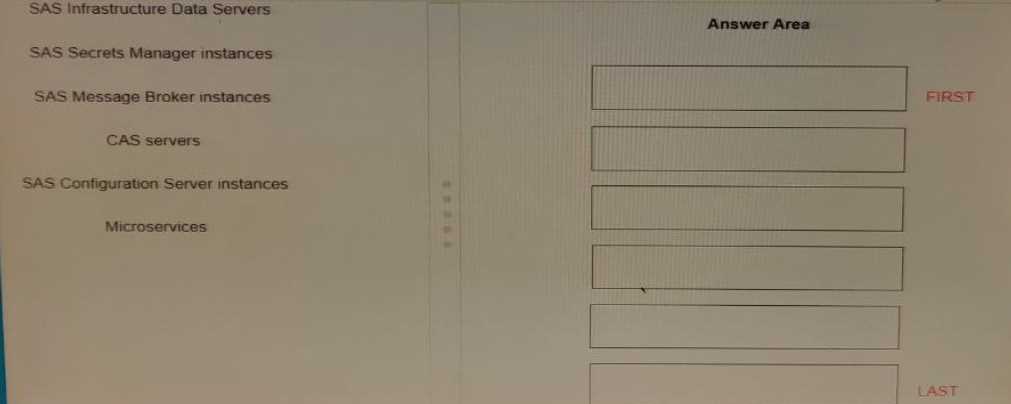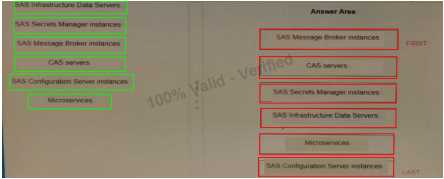sas a00-251 practice test
SAS Certified Specialist Administration of SAS Viya 3.5
Question 1
How can you determine the machine on which your SAS Viya servers and services are deployed?
(Choose two.)
- A. Servers page in SAS Environment Manager
- B. /opt:/sas/viya/home/sas-admin machines services list
- C. Machines page in SAS Environment Manager
- D. /opt/sas/viya/home/bin/sas-admin healthcheck services instances list
Answer:
AC
Explanation:
"The Servers page displays the servers and services that have been deployed on each machine, as
well as their current status. The Machines page displays information about each machine and its
resources. This includes the server types, operating system, and number of available cores for each
machine."
Question 2
Where can you find the CAS super user role membership in SAS Environment Manager?
- A. Server properties on the Data page
- B. Custom Groups on the Users page
- C. Server Settings on the Server page
- D. CAS Management service on the Configuration page
Answer:
D
Explanation:
The CAS Management service page in SAS Environment Manager provides the ability to configure
CAS super user role membership. This allows you to add and remove users from the CAS super user
role, as well as view which users currently have a CAS super user role membership.
Question 3
When restoring from a default backup, which SAS Viya component must be manually restored?
- A. SAS Infrastructure Data Server
- B. SAS Message Broker
- C. SAS Configuration Server
- D. CAS Server
Answer:
D
Explanation:
The CAS Server must be manually restored when restoring from a default backup. According to the
official SAS documentation, "If you restore the CAS Server from a backup, you must install and
continue to use the same version of the server that was used at the time of the backup."
Question 4
Where does a SAS administrator make modifications to add global-scope caslibs or load global-scope
tables to the CAS server?
- A. casconfigusermods.lua
- B. node_usermods.lua
- C. cas_usermods.lua
- D. casstartup_usermods.lua
Answer:
C
Explanation:
The cas_usermods.lua file is where SAS administrators can make modifications to add global-scope
caslibs or load global-scope tables to the CAS server. The CAS configuration server monitors the
cas_usermods.lua file and applies the settings whenever it changes.
Question 5
When managing an existing SAS Viya deployment, which situations describe when you need to
obtain a new software order? (Choose two.)
- A. Adding on a new product
- B. Applying a hot fix
- C. Updating TLS certificates
- D. Upgrading to a newer version
Answer:
AD
Explanation:
When you add on a new product or upgrade to a newer version of SAS Viya, you will need to obtain a
new software order. This is because these changes involve additional or updated software
components that are not covered under your existing license agreement.
Note: If you are only applying a hotfix or updating TLS certificates, you do not need to obtain a new
software order. These changes do not involve additional or updated software components and can be
done under your existing license agreement.
Question 6
An administrator needs to restart only the SAS Logon service. Which is a valid method for doing that?
- A. Using the sas-admin CLI command with the saslogon service-id
- B. Using the CAS Server Monitor
- C. Using the operating system's service management utility
- D. Using the SAS Environment Manager Dashboard
Answer:
A
Explanation:
According to the official SAS Viya 3.5 documentation, the CLI command to restart the SAS Logon
service is sas-admin service restart saslogon. You can find this information in the SAS Viya 3.5
Administering Guide page 22.
Question 7
Which statement about the CAS backup controller is FALSE?
- A. A CAS backup controller can be deployed to the same machine as a CAS worker
- B. CAS supports adding only one backup controller
- C. CAS supports adding a backup controller after the initial deployment
- D. A CAS backup controller can only be used in a distributed CAS server architecture.
Answer:
B
Explanation:
CAS can support multiple backup controllers in a distributed architecture, which can improve
performance and provide redundancy. Additionally, a backup controller can be added after the initial
deployment, which can be useful for managing a large number of CAS workers.
It is false statement because CAS supports adding more than one backup controller in a CAS server
architecture. The CAS Backup Controller is a separate process that runs alongside the CAS Controller
and monitors the health of the CAS processes. It can be deployed on a separate machine or on the
same machine as a CAS worker. The backup controller can be added during the initial deployment or
after the initial deployment.
A CAS Backup controller is used in a distributed CAS server architecture but it can also be used in a
single machine architecture too. CAS Backup controller provides an additional level of redundancy, in
case the primary CAS controller goes down, it can take over its responsibilities.
Question 8
You have an MPP SAS Viva environment with a primary CAS Controller and a backup CAS Controller.
The primary controller fails and your backup controller is now active.
Which task will you need to complete during the process of recovering the primary controller?
- A. Delete the permstore from the backup controller.
- B. Stop SAS services on all the CAS workers.
- C. Restore the permstore from the backup controller to the primary controller.
- D. Restore CASDISKCACHE from the backup controller to the primary controller.
Answer:
C
Explanation:
When recovering a primary controller, you need to restore the permstore from the backup controller
to the primary controller. The permstore contains the state of the CAS session and other important
information related to the CAS environment, such as configuration, metadata, and user data.
Restoring the permstore from the backup controller allows the primary controller to resume
operation with minimal data loss.
The process of restoring the permstore from the backup controller to the primary controller can be
done by using the sas-admin permstore-restore command.
Reference:
https://www.sas.com/en_us/support/documentation/viya-books/cas-admin/cas-admin-backup-and-recovery.html#zid-12719
It is important to note that, before restoring the permstore, you should stop SAS services on all the
CAS workers, in order to avoid data corruption during the restore process. Also, it is not
recommended to delete the permstore from the backup controller, as it is useful in case of primary
controller failure. CASDISKCACHE is used for caching purpose, it's not related to permstore or
primary controller failure.
Question 9
DRAG DROP
(**Note: This is an interactive item Follow the instructions to answer the question Scroll bars may
appear if the windows are too small Each window can be re-sized by dragging on the 5 circles located
between windows )
Drag the server and service groups from left to right and order them from top to bottom in the order
in which they should be STOPPED.
Answer:
Explanation:
Question 10
To prepare for an update using the deployment mirror repository, what tool is used to download the
most current Viya software from SAS?
- A. SAS Mirror Manager
- B. Ansible
- C. SAS Deployment Manager
- D. SAS Orchestration CLI
Answer:
A
Explanation:
SAS Mirror Manager is a tool that is used to download the most current Viya software from SAS and
prepare the deployment mirror repository for an update. The SAS Mirror Manager is a command-line
interface (CLI) tool that is used to create, manage and update deployment mirror repositories. It
allows you to download software components from the SAS Software Depot and store them in a local
repository. This enables you to perform updates and new installations of SAS Viya without requiring
internet access.
Reference:
https://www.sas.com/en_us/support/documentation/viya-books/sas-viya-deployment-wizard/using-the-mirror-manager.html
Question 11
In a programming-only SAS Viya deployment, which web application is available?
- A. SAS Studio
- B. SAS Visual Analytics
- C. SAS Dove
- D. SAS Environment Manager
Answer:
A
Explanation:
In a programming-only SAS Viya deployment, the web application SAS Studio is available. SAS Studio
is a web-based application that provides a workspace for SAS programmers to access, manage, and
analyze data, as well as creating, running and debugging SAS programs. This application is designed
for data scientists, statisticians, and programmers who need to perform advanced analytics tasks,
including data visualization, data exploration, and data modeling.
Reference:
https://www.sas.com/en_us/software/sas-studio.html
Question 12
All servers and services in a distributed SAS Viya Environment are stopped. An administrator needs to
start them in the correct order. Which server must be started first?
- A. SAS Infrastructure Data Server (PostgreSQL)
- B. SAS Secrets Manager (Vault)
- C. SAS Message Broker (RabbitMQ)
- D. SAS Configuration Server (Consul server)
Answer:
D
Explanation:
In a distributed SAS Viya environment, the SAS Configuration Server (Consul server) must be started
first. The Consul server is the foundation of the SAS Viya environment and provides service discovery
and configuration management for all other servers and services. It is responsible for maintaining the
configuration information and state of the SAS Viya environment, including the location and status of
all servers and services.
Reference:
https://www.sas.com/en_us/support/documentation/viya-books/cas-admin/cas-admin-installation-and-configuration.html#zid-12718
Question 13
Which SAS Viya application is hosted by the embedded web application server?
- A. SAS Studio Enterprise
- B. SAS Visual Analytics
- C. SAS Data Explorer
- D. SAS Studio Basic
Answer:
D
Explanation:
According to the official SAS Viya 3.5 documentation, SAS Studio Basic is the only SAS Viya
application that is hosted by the embedded web application server. You can find this information in
the SAS Viya 3.5 Administering Guide page 13.
Question 14
What is NOT TRUE about SAS Studio Enterprise?
- A. SAS Studio Enterprise is a microservice.
- B. SAS Studio Enterprise uses the workspace server
- C. SAS Studio Enterprise uses the launcher server.
- D. SAS Studio Enterprise uses the compute server.
Answer:
A
Explanation:
SAS Studio Enterprise is not a microservice, it's a web-based application that provides a
programming interface, data visualization and an environment for managing analytics workflows, it's
part of the SAS Viya suite of products.
SAS Studio Enterprise uses the workspace server, launcher server and the compute server, these
servers are the core of the SAS Studio Enterprise's functionality, and they are responsible for
performing various tasks related to data access, computation, and execution of SAS programs. The
workspace server provides a web-based interface for working with data and SAS programs, while the
launcher server manages the execution of SAS programs, and the compute server provides the
computational resources for running SAS programs.
Question 15
Which SAS Environment Manager function would you select to change the retention period for
storing backups'?
- A. Content
- B. Configuration
- C. Backup and Restore
- D. Jobs and Flows
Answer:
C
Explanation:
According to the official SAS Viya 3.5 documentation, the Backup and Restore function in SAS
Environment Manager is used to configure the retention period for storing backups. You can find this
information in the SAS Viya 3.5 Administering Guide page 21.
The Backup and Restore function in SAS Environment Manager would be used to change the
retention period for storing backups. This function provides options to configure the backup
schedule, retention period, and other settings related to the backup process. You can also use this
function to perform ad-hoc backups or restore from a previous backup.
Reference:
https://www.sas.com/en_us/support/documentation/viya-books/environment-manager-admin/environment-manager-admin-backup-and-recovery.html
The Content function is used to manage the content and metadata of the SAS Environment Manager.
The Configuration function is used to configure the settings of the SAS Environment Manager. The
Jobs and Flows function is used to manage and monitor the jobs and flows running in the SAS
Environment Manager.